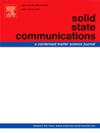外加均匀应变对石墨烯双层结构等离子体模式的影响
IF 2.1
4区 物理与天体物理
Q3 PHYSICS, CONDENSED MATTER
引用次数: 0
摘要
在这项工作中,均匀应变双层石墨烯结构中的电荷密度激发在应变张量中进行了一阶。利用已报道的各向异性费米速度张量的低能狄拉克哈密顿量,可以用线性响应理论和弱外场作用下密度响应函数与感应电流密度的关系来描述等离激元的性质。我们发现,石墨烯双层的光学和声学模式的等离子体能量在很大程度上取决于它们的光学各向异性张量电导率、应变模量和施加张力的方向。此外,我们确定等离子激元的激发是基于观察到的各向异性石墨烯结构的反射系数在Kretchmann构型的入射角和应变下的深锐最小值。由于应变导致石墨烯的光学电导率各向异性,应变相关的取向在操纵石墨烯等离子体能量的变化中起着重要作用,这可能有助于调整等离子体器件中的石墨烯性质以增强光-物质相互作用。本文章由计算机程序翻译,如有差异,请以英文原文为准。
Effect of applied uniform strain on the plasmon modes in graphene double-layer structures
In this work, charge density excitations in uniformly strained double-layer graphene structures are carried out up to first order in the strain tensor. Taking the reported low energy Dirac Hamiltonian for the anisotropic Fermi velocity tensor, plasmon properties may be described by linear response theory and the relationship between the density response function and induced current density under a weak external applied field. We show that plasmon energies of the optical and acoustic modes of the graphene double-layers depend substantially on their optical anisotropic tensor conductivity, the strain modulus and the direction of the applied tension. Also, we determine that plasmon excitation is based on the observation of a deep sharp minimum in the reflection coefficient of the suggested anisotropic graphene structure upon the incident angle and strain in the Kretchmann configuration. Because strain induces anisotropy in graphene optical conductivity, the strain-dependent orientation plays an important role to manipulate the variations of the graphene plasmon energy, which may be useful to tune graphene properties in plasmonic devices to enhance light-matter interaction.
求助全文
通过发布文献求助,成功后即可免费获取论文全文。
去求助
来源期刊

Solid State Communications
物理-物理:凝聚态物理
CiteScore
3.40
自引率
4.80%
发文量
287
审稿时长
51 days
期刊介绍:
Solid State Communications is an international medium for the publication of short communications and original research articles on significant developments in condensed matter science, giving scientists immediate access to important, recently completed work. The journal publishes original experimental and theoretical research on the physical and chemical properties of solids and other condensed systems and also on their preparation. The submission of manuscripts reporting research on the basic physics of materials science and devices, as well as of state-of-the-art microstructures and nanostructures, is encouraged.
A coherent quantitative treatment emphasizing new physics is expected rather than a simple accumulation of experimental data. Consistent with these aims, the short communications should be kept concise and short, usually not longer than six printed pages. The number of figures and tables should also be kept to a minimum. Solid State Communications now also welcomes original research articles without length restrictions.
The Fast-Track section of Solid State Communications is the venue for very rapid publication of short communications on significant developments in condensed matter science. The goal is to offer the broad condensed matter community quick and immediate access to publish recently completed papers in research areas that are rapidly evolving and in which there are developments with great potential impact.
 求助内容:
求助内容: 应助结果提醒方式:
应助结果提醒方式:


